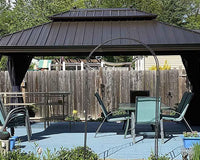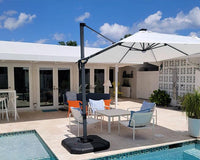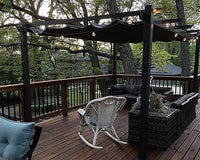A gazebo is a great feature of any backyard, providing a shaded area to relax, entertain, or even use as an outdoor workspace. Connecting electricity to your gazebo can make it even more functional, supporting lighting, fans, music, or even an outdoor refrigerator. Yet, extending electrical power outdoors is very much a matter of planning and following safety guidelines. Let me take you through the necessary steps and factors for safely connecting power to your gazebo.
Why Proper Planning is Crucial Before Electrifying Your Gazebo
Safety has to be your very first concern before you even consider purchasing wire. Working with electricity, particularly outside where moisture comes into play, is extremely dangerous when not done right.
Understand Your Needs
What do you want to power in your gazebo?
- Lighting: String lights, overhead fixtures, accent lights?
- Outlets: For charging phones, running small appliances, a mini-fridge, or power tools?
- Ceiling Fan: A great addition for comfort.
Knowing your power requirements will help determine the type of circuit, wire gauge, and number of outlets you'll need. Overloading a circuit is a fire hazard.

Check Local Codes and Permits
This is non-negotiable. Most areas require permits for running new electrical circuits, especially outdoors. Your local building department will have specific codes regarding burial depth for wires, types of conduit, GFCI protection, and other safety measures for outdoor electrical installations connected to a gazebo. Failing to comply can result in fines, unsafe conditions, and issues if you ever sell your home.
What are Your Options for Getting Power to the Gazebo?
There are generally two main approaches to routing electricity to a detached structure like a gazebo.
Underground Wiring
Running electrical cable underground in a suitable conduit is the most common and generally the safest and most aesthetically pleasing method for a permanent gazebo installation.
- Trenching: This involves digging a trench from your home's power source (usually an exterior wall or an existing outdoor junction box) to the gazebo. The required depth of the trench varies by local code but is often 18-24 inches for PVC conduit or direct burial cable (though direct burial is less common for DIYers and has specific requirements).
- Conduit: Using PVC or metal conduit protects the wires from damage and moisture. Individual THWN/THHN wires are typically pulled through the conduit.
- Direct Burial Cable (UF-B): This type of cable is rated for direct burial without conduit in some situations, but it must be buried deeper and is more susceptible to damage. Conduit is often still recommended for sections near the surface or where future digging might occur.
Overhead Wiring (Less Common for Gazebos)
While possible, running an overhead electrical line to a gazebo is less common for aesthetic and safety reasons in residential settings. It requires specific clearances, proper support, and can be more visually obtrusive. This method is usually more suited for workshops or larger outbuildings and often requires professional assessment.

Essential Safety Components for Your Gazebo's Electrical System
Outdoor electrical installations for your gazebo require specific safety features due to exposure to the elements.
GFCI Protection is a Must
All outlets and lighting circuits in your gazebo (and any outdoor location) must be protected by a Ground Fault Circuit Interrupter (GFCI). GFCIs detect imbalances in current flow (like those caused by moisture creating a path to ground) and quickly shut off the power, preventing electric shock. This protection can be provided by a GFCI circuit breaker in your main electrical panel or by installing GFCI receptacles as the first outlet on the circuit within the gazebo.
Weatherproof Enclosures for Your Gazebo
All electrical boxes, outlets, and switches installed outdoors or within the structure of your gazebo must be specifically designed for outdoor use. This means using weatherproof boxes and "in-use" covers for receptacles. These covers (often called "bubble covers") protect the outlet and whatever is plugged into it from rain and moisture. Using weather-resistant (WR) rated outlets is also critical.
Don't Forget Proper Grounding
An unbroken and reliable course to ground is vital for safety. Ensure the entire electrical system in your gazebo, including any metal components of the building, if required by code (e.g., a metal roof or frame), is properly grounded back to the main grounding system of your house. This helps to dissipate any fault currents.

The Installation Process: Wiring Up Your Gazebo
Once the trench has been dug and the conduit or cable is in place (all depth and clearance conditions from other utilities), the wiring of the gazebo itself proceeds. This would usually start by bringing in the power to an exterior-rated junction box on or near the gazebo.
Wiring will be run inside this junction box to the locations of your lights, switches, and outlets in your hardtop gazebo. How wiring is done is dependent upon the design of the gazebo. It may be installed inside hollow poles, along beams (encased by conduit if they are exposed), or with surface-mounted weather-resistant outdoor conduit and boxes if there isn't any provision for the building of the gazebo to conceal wiring. All wiring methods must protect the wires from physical damage and from harm due to wetness and moisture.So choosing a hardtop gazebo is an excellent choice, especially when you consider local regulations and permit requirements for outdoor structures
Making Connections and Why Professional Help is Often Best for Your Gazebo
All electrical connections – splicing wires, connecting to switches, outlets, and light fixtures – must be made securely inside approved electrical boxes using appropriate wire connectors (like wire nuts or Wago connectors). Loose or improper connections are a major cause of electrical problems and fire hazards.
A Strong Recommendation: Consider an Electrician
While this guide gives you an overview, it's crucial to emphasize that working with electricity is inherently dangerous and can be fatal if done incorrectly. Electrical codes are complex and vary by location. If you are not a licensed and experienced electrician, or if you feel uncomfortable or uncertain about any part of this project, it is strongly recommended to hire a qualified electrician. They have the knowledge, tools, and understanding of local codes to ensure your gazebo power installation is safe, compliant, and reliable. The cost of professional help is a small price for peace of mind and, most importantly, safety.

Final Steps: Inspection and Enjoying Your Powered Gazebo
After all the electrical work for your gazebo is completed (whether by you, if you are qualified, or by a professional), it will almost certainly need to be inspected by your local electrical inspector. They will review the installation to ensure it meets all applicable safety codes and standards. Do not use the new circuit until it has passed this inspection.
Once you have that green light from the inspector, it's time to enjoy the enhanced comfort and functionality of your conveniently powered and beautifully lit gazebo!
Bringing electricity to your gazebo can truly transform it into a more versatile and enjoyable outdoor living space for relaxation and entertaining. However, always remember that prioritizing safety, understanding and adhering to local codes, and knowing when to call in a professional are the most important steps in this entire process.




